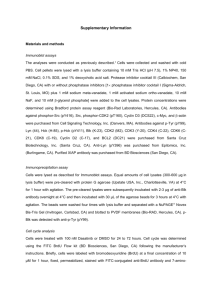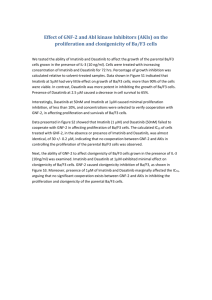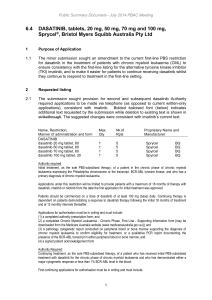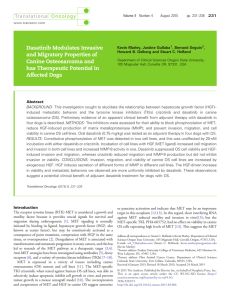Tables - BioMed Central
advertisement
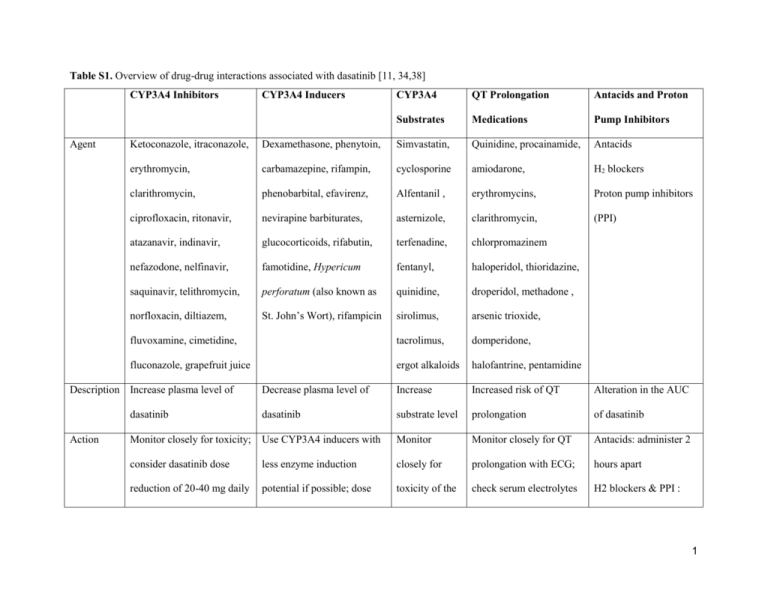
Table S1. Overview of drug-drug interactions associated with dasatinib [11, 34,38] CYP3A4 Inhibitors Agent CYP3A4 QT Prolongation Antacids and Proton Substrates Medications Pump Inhibitors Ketoconazole, itraconazole, Dexamethasone, phenytoin, Simvastatin, Quinidine, procainamide, Antacids erythromycin, carbamazepine, rifampin, cyclosporine amiodarone, H2 blockers clarithromycin, phenobarbital, efavirenz, Alfentanil , erythromycins, Proton pump inhibitors ciprofloxacin, ritonavir, nevirapine barbiturates, asternizole, clarithromycin, (PPI) atazanavir, indinavir, glucocorticoids, rifabutin, terfenadine, chlorpromazinem nefazodone, nelfinavir, famotidine, Hypericum fentanyl, haloperidol, thioridazine, saquinavir, telithromycin, perforatum (also known as quinidine, droperidol, methadone , norfloxacin, diltiazem, St. John’s Wort), rifampicin sirolimus, arsenic trioxide, fluvoxamine, cimetidine, tacrolimus, domperidone, fluconazole, grapefruit juice ergot alkaloids halofantrine, pentamidine Decrease plasma level of Increase Increased risk of QT Alteration in the AUC dasatinib dasatinib substrate level prolongation of dasatinib Monitor closely for toxicity; Use CYP3A4 inducers with Monitor Monitor closely for QT Antacids: administer 2 consider dasatinib dose less enzyme induction closely for prolongation with ECG; hours apart reduction of 20-40 mg daily potential if possible; dose toxicity of the check serum electrolytes H2 blockers & PPI : Description Increase plasma level of Action CYP3A4 Inducers 1 increases of dasatinib in 20 substrates (potassium &magnesium) avoid if possible, mg increments are and correct prior to substitute with antacids recommended. initation of dasatinib and during therapy. 2 Table S2. Response rates in phase II START programs of dasatinib [39, 42-48] START-R Studya START-C START-A START-B START-L High-dose Dasatinib imatinib (800 mg/day) N 387 174 109 48 101 49 Disease stage CP AP MBP LBP CP CP 15.2 14.1 20a 20a 15 15 CHR 91 45 27 29 93 82b MCyR 59 39 33 52 52 33c CCyR 49 32 26 46 40 16d Median followup, months Response (%) AP, accelerated phase CML; CCyR, complete cytogenetic response; CHR, complete hematologic response; CP, chronic phase CML; CML, chronic myelogenous leukemia; LBP, lymphoid blast phase CML; MBP, myeloid blast phase CML; MCyR, major cytogenetic response a 70 mg twice daily dasatinib was used in all studies and the maximum duration of follow-up is reported. 3 b c P = .034 P = .023 d P = .004 4 Table S3. Management recommendations of neutropenia and thrombocytopenia associated with dasatinib [34] CP CML Monitoring: ANC <0.5 x 109/L and/or (starting dose Complete blood counts (CBC platelets <50 x 109/L 100 mg QD) with differential) weekly for 1. Stop dasatinib until ANC ≥1.0 x 109/L and platelets ≥50 x 109/L 2. Resume treatment at the original starting dose if recovery occurs in ≤ 7 days first 2 months and then 3. If platelets <25 x 109/L and/or recurrence of ANC <0.5 x monthly thereafter, or as 109/L for >7 days, repeat step 1 and resume dasatinib at a clinically indicated reduced dose of 80 mg QD (second episode) or discontinue (third episode) AP CML, BP Monitoring ANC <0.5 x 109/L and/or CML and Ph+ Complete blood counts (CBC platelets <10 x 109/L ALL (starting with differential) as clinically dose 70 mg BID) indicated 1. Determine whether cytopenia is related to leukemia (using marrow aspirate and/or biopsy) 2. If cytopenia is unrelated to leukemia, stop dasatinib until ANC ≥1.0 x 109/L and platelets ≥20 x 109/L and resume at the original starting dose 3. If recurrence of cytopenia, repeat step 1 and resume dasatinib at a reduced dose of 50 mg BID (second episode) or 40 mg BID (third episode) 5 4. If cytopenia is related to leukemia, consider dose escalation to 100 mg BID ANC = absolute neutrophil count; AP, accelerated phase; BID = twice daily; BP, blast phase; CML, chronic myelogenous leukemia; CP, chronic phase; Ph+ ALL, Philadelphia chromosome positive acute lymphoblastic leukemia; QD = once daily 6 Table S4. Management recommendations for severe (Grade 3/4) nonhematologic adverse events associated with dasatinib [11] Adverse Event Incidencea,b Signs and Monitoring Interventionb,c Evaluate by Grade 3: (Definition: Symptomatic and supplemental oxygen, >2 chest X-ray therapeutic thoracenteses, tube drainage, or pleurodesis upon indicated) presentation of Interupt dasatinib treatment. Initiate oxygen and diuretics. For signs and significant symptoms use a short course of steroids (prednisone 20 symptoms mg/day x 3). Symptoms Pleural 22% (all effusions grades); 5% Dyspnea Dry cough (grades 3/4) Rapid weight gain Grade 4: (Definition: Life-threatening [e.g.,causing hemodynamic instability or ventilator support]) Hold dasatinib until grade 1 or better, then consider resuming dose at a reduced dose level.d Supportive care with diruetics, oxygen, and systemic steroids. Headache 24% (all Pain in the head, Self-monitoring Grade 3: (Definition:Severe pain; pain or analgesics severely grades); 1% blurred vision, and rating of interfering with ADL) 7 (grades 3/4) nausea, vomiting, headache hearing impairment, intensity Supportive care with analgesics. Grade 4: (Definition: Disabling) irritability, malaise Hold dasatinib until grade 1 or better, then consider resuming dose at a reduced dose level.d Supportive care with analgesics Nausea 22% (all Nausea, belching, NA Grade 3: (Definition: Inadequate oral caloric or fluid intake; IV grades); 1% heartburn, cramping, fluids, tubefeedings, or TPN indicated ≥24 hrs) (grades 3/4) abdominal distention Hold dasatinib until grade 1 or better. Supportive care with antiemetic(s), fluid and electrolytes as needed. Grade 4: (Definition: Life-threatening consequence) Hold dasatinib until grade 1 or better, then consider resuming dose at a reduced dose level.d Supportive care with antiemetic(s), fluid and electrolytes as needed. Diarrhea NA Grade 3: (Definition: Increase of ≥7 stools per day over baseline; 31% (all Frequent, loose, grades); 3% watery stools, incontinence; IV fluids ≥24 hrs; hospitalization; severe increase (grades 3/4) abdominal cramps, in ostomy output compared to baseline; interfering with ADL) 8 bloating, may be Hold dasatinib. Supportive care with anti-diarrheals, fluid and preceded by nausea electrolytes replacement. and vomiting Grade 4: (Definition: Life-threatening consequences (e.g. hemodynamic collapse) Hold dasatinib until grade 1 or better, then consider resuming dose at a reduced dose level.d Supportive care with anti-diarrheals, fluid and electrolytes relplacement. Gastrointestinal 3% (all Blood in the stool; Platelet counts Grade 3 (Definition:Transfusion, interventional radiology, bleeding (GI grades); 1% diarrhea; signs and endoscopic, or operative intervention indicated) and Grade 4 Hemorrhage) (grade 3/4) symptoms of anemia (Definition: Life-threatening consequences; major urgent due to blood loss intervention indicated) Modify dasatinib dose according to recommendations for thrombocytopenia (Table 4). For severe GI hemorrhages, dasatinib treatment must be interrupted and blood product transfusion may be indicated. Dasatinib may be reintroduced with caution at a lower dose level. 9 Rash NA Symptomatic control with Regenecare™ for itch and pain, with or 22% (all Itching, pain, grades); 1% swelling, without minocycline for inflammation. Topical or systemic (grades 3/4) erythemapustular steroids may be considered in severe cases. Dose reduction, lesions interruption or discontinuation of dasatinib may be indicated depending on presenting conditions of the skin rash. a Incidence across all clinical trials of dasatinib b Grading system per the National Cancer Institute Common Terminology Criteria for Adverse Events Version 3.0 (NCI CTCAE v3.0): grade 1 = mild, grade 2 = moderate; grade 3 = severe; grade 4 = life-threatening/disabling c Interventions recommended by the National Comprehensive Cancer Network (NCCN) d Dose reductions: Chronic phase, 100 mg once daily 80 mg once daily (-1 level); Advanced phase, 70 mg twice daily 50 mg twice daily (-1 level) 40 mg twice daily (-2 level) 10
